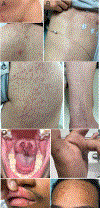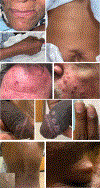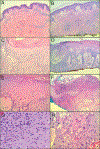A plague passing over: Clinical features of the 2022 mpox outbreak in patients of color living with HIV
- PMID: 37336551
- PMCID: PMC10592586
- DOI: 10.1111/hiv.13517
A plague passing over: Clinical features of the 2022 mpox outbreak in patients of color living with HIV
Abstract
Introduction: Compared with previous geographically localized outbreaks of monkeypox (MPOX), the scale of the 2022 global mpox outbreak has been unprecedented, yet the clinical features of this outbreak remain incompletely characterized.
Methods: We identified patients diagnosed with mpox by polymerase chain reaction (PCR; n = 36) from July to September 2022 at a single, tertiary care institution in the USA. Demographics, clinical presentation, infection course, and histopathologic features were reviewed.
Results and conclusion: Men who have sex with men (89%) and people living with HIV (97%) were disproportionately affected. While fever and chills (56%) were common, some patients (23%) denied any prodromal symptoms. Skin lesions showed a wide range of morphologies, including papules and pustules, and lesions showed localized, not generalized, spread. Erythema was also less appreciable in skin of colour patients (74%). Atypical clinical features and intercurrent skin diseases masked the clinical recognition of several cases, which were ultimately diagnosed by PCR. Biopsies showed viral cytopathic changes consistent with Orthopoxvirus infections. All patients in this case series recovered without complications, although six patients (17%) with severe symptoms were treated with tecovirimat without complication.
Keywords: HIV; dermatology; histopathology; infection control; infectious disease; mpox; orthopoxviruses; poxviridae; skin of colour; tecovirimat; testing.
© 2023 The Authors. HIV Medicine published by John Wiley & Sons Ltd on behalf of British HIV Association.
Conflict of interest statement
Figures



Comment in
-
Comment on "A plague passing over: clinical features of the 2022 mpox outbreak in patients of colour living with HIV".HIV Med. 2023 Nov;24(11):1164. doi: 10.1111/hiv.13528. Epub 2023 Jul 23. HIV Med. 2023. PMID: 37485576 No abstract available.
References
-
- WHO. Monkeypox: experts give virus variants new names. Vol 2022, World Health Organization, 2022.
Publication types
MeSH terms
Grants and funding
LinkOut - more resources
Full Text Sources
Medical

